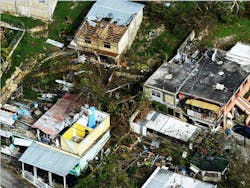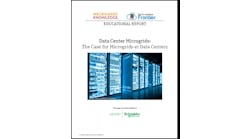Hurricane Maria showed that warnings about the vulnerabilities of centralized electric grids – and the need for microgrid development — are not overstated.
When the hurricane hit the U.S. territory on September 20, it knocked out power to 100 percent of 1.57 million accounts served by the Puerto Rico Electric Power Authority (PREPA), the island’s utility.
Things were not much better 10 days later — 95 percent of the accounts remained without power, according to a September 30 report by the Department of Energy.
Worse, the destruction is so massive, with 80 percent of the island’s transmission and distribution system destroyed, that power may not be fully restored to the island’s 3.4 million people until next year. In fact, the Puerto Rico Electric Power Authority (PREPA), the island’s utility, is warning that 50 percent of customers may still be without power two or three months from now.
Despite the mobilization of mainland contractors and utilities, repairing the grid is “going to be overwhelming,” PREPA CEO Ricardo Ramos told CNBC.
The island has backup generators, but diesel fuel quickly became scarce, as the island waited for mainland supplies to arrive. Lack of power left some hospitals unable to operate on patients and provide other critical services.
“My people’s lives are at stake,” said San Juan Mayor Carmen Yulín Cruz in a YouTube plea last week.
This kind of scenario is exactly what microgrid proponents have described as possible anywhere when electric reliability depends almost solely on an interconnected central grid without the support of microgrids and related distributed energy. Before, the argument may have sounded hypothetical, improbable, maybe even apocalyptic. Puerto Rico made it real.
Hurricane Maria offered up a new twist on the old Chicken Little story. It turns out that the acorn that dropped on the chicken’s head was a signal that the sky, in fact, can fall.
How will this year’s devastating hurricane season affect the microgrid industry? Find out at Microgrid 2017, Nov. 6-8 in Boston.
Puerto Rico’s long-term energy plan needs to include microgrids
With the focus now on survival, most Puerto Ricans are probably not thinking about long-term energy planning. But “there is a huge opportunity, one or two years out, for building the grid in a more sustainable way,” said Cathy Kunkel, an energy analyst with the Institute for Energy Economics and Financial Analysis
Kunkel is deeply familiar with Puerto Rico’s power woes, which began long before the hurricane. Brought to the island two years ago to help an environmental organization, she has been focused on utility rate and resource planning issues.
Rebuilding will not be easy, she warned. The utility was besieged by debt prior to the hurricane and has an old-school grid, heavily reliant on aging, oil-fired power plants.
“It was a horrible lump for them that it was the worse hurricane since 1928. That would have done damage to the best of grids,” Kunkel said.
Microgrid lesson from Haiti
Microgrids stand less chance of getting damaged because they do not transmit electricity long-distances over storm-vulnerable wire. For the same reason, they are likely to get up and running more quickly after a storm — they are located near the customers they serve.
Haiti offers an example of microgrid resiliency. Last year, Hurricane Matthew partially damaged a microgrid solar array built in Les Anglais by EarthSpark International, a non-profit microgrid developer.
But with the system’s power electronics and battery bank left unscathed, EarthSpark was able to restore enough of the solar array to get power flowing in a relatively straightforward fashion, according to Allison Archambault, EarthSpark president.
“With the [solar] PV plus battery storage, we were able to serve community needs and businesses with higher levels of power directly from the generation site,” she said.
The organization is now starting repair to the distribution part of the system, which was delayed as the Haitian community dealt with more immediate needs. Many had no homes to even connect to the microgrid.
“After the storm hit, electricity was not the priority in Les Anglais; shelter, water purification tabs, food, and health care were all more pressing needs,” Archambault said. “Even had we had funding to immediately repair the distribution system, we would not have been able to connect customers because, sadly, most of our clients had lost their homes and businesses and needed to rebuild before electricity could be safely restored.”
Transmission wires and storms: a bad mix
Downed by falling poles and trees, wires are a major source of power outages in a wind storm. And unfortunately, Puerto Rico’s electric system depends heavily on long distance high voltage transmission lines that run the span of the island. Large power plants are situated on the south side to the island, while the population center is in the north, according to Kunkel.
Where central grids exist – like the Puerto Rico and the U.S. — a microgrid will island or separate from the grid when wires are failing. This spares the microgrid from becoming victim of a cascading failure on the grid. The microgrid activates its onsite power sources — renewables, batteries, generators — and they serve nearby customers.
Eight Ways a Microgrid Will Improve Your Operation…and the World
“As costs for on-site PV+storage come down, and as microgrids become more possible and prevalent, planners should be weighing the value of local resiliency against the cost of transmission lines,” said EarthSpark’s Archambault. “Of course transmission lines are critical in many cases, but they should no longer be viewed as the only — or even always the best — option.”
Future poster child for distributed energy?
Besides lacking capital, Puerto Rico’s electricity industry struggled under competing visions for the future even before the storm, according to Kunkel. PREPA wanted to retain a centralized grid, but switch power plants from oil to liquified natural gas (LNG). Since the island has no LNG, the utility sought permission to build a terminal so that it could import the fuel.
Others like Kunkel advocated for more decentralization and renewable energy to strengthen the system.
No decision had been made on the LNG terminal before Hurricane Maria. Kunkel pointed out that had it been built, chances are it may have been damaged by the storm.
“Hurricane Maria shows the dangers of the path PREPA was trying to go down,” she said. “The frustrating thing to me is that it’s unreasonable to say they didn’t see this coming. It is a tropical island that was in the path of hurricanes and had a decrepit grid running on a shoe string. We’re seeing the consequences of that.”
But now Puerto Rico could remake itself into “the poster child for distributed energy,” she said.
“If you’re talking about building a grid from scratch, I don’t know why you wouldn’t rebuild it in a much more decentralized way,” she said. “We have the technology now to do it. You certainly can set it up in a way where hospitals and emergency centers would not go dark and would not be relying on diesel fuel in an emergency. Generators are good backup, but only when they do not run out of fuel.”
Microgrids typically have more than one form of generation. On a sunny island, that’s likely to include solar and batteries, along with backup generators.
[clickToTweet tweet=”The sky fell in Puerto Rico. Turns out Chicken Little was not exaggerating. #microgrids” quote=”The sky fell in Puerto Rico. Turns out Chicken Little was not exaggerating. “]
Lessons for the mainland
Like Puerto Rico, the U.S. grid is largely centralized, so also is vulnerable to severe storms. It stands a better chance of withstanding a severe storm than Puerto Rico because its grid is mostly newer with more advanced technology.
Still, when Hurricane Irma struck in September, 4.4 million customers of Florida Power & Light lost power, and it took 10 days for complete restoration. The lengthy outages occurred despite $3 billion in upgrades made to the central grid over the last 11 years. Florida has few microgrids.
Following Superstorm Sandy five years ago, the U.S. Northeast began building microgrids, spurred by significant state funding. New York is going a step further, setting up a regulatory structure for systemic grid decentralization through its Reforming the Energy Vision.
New York Governor Andrew Cuomo was aboard the first flight to land in Puerto Rico after Hurricane Maria.
“My opinion is, in person it is much worse than it appears on the TV reports,” Cuomo said in a news conference following his tour of the island. “The entire power system on the island is down.”
The hurricane season of 2018 is likely to reframe the way the U.S. looks at grid decentralization. Now states see clearly what it means to a North American society when an entire grid, in this case one serving over 3 million people, is wiped away. As Cuomo added, “Until the power grid is up, it’s very hard to do anything else.”
Read more about how microgrids withstand hurricanes. Subscribe to the free Microgrid Knowledge newsletter.







